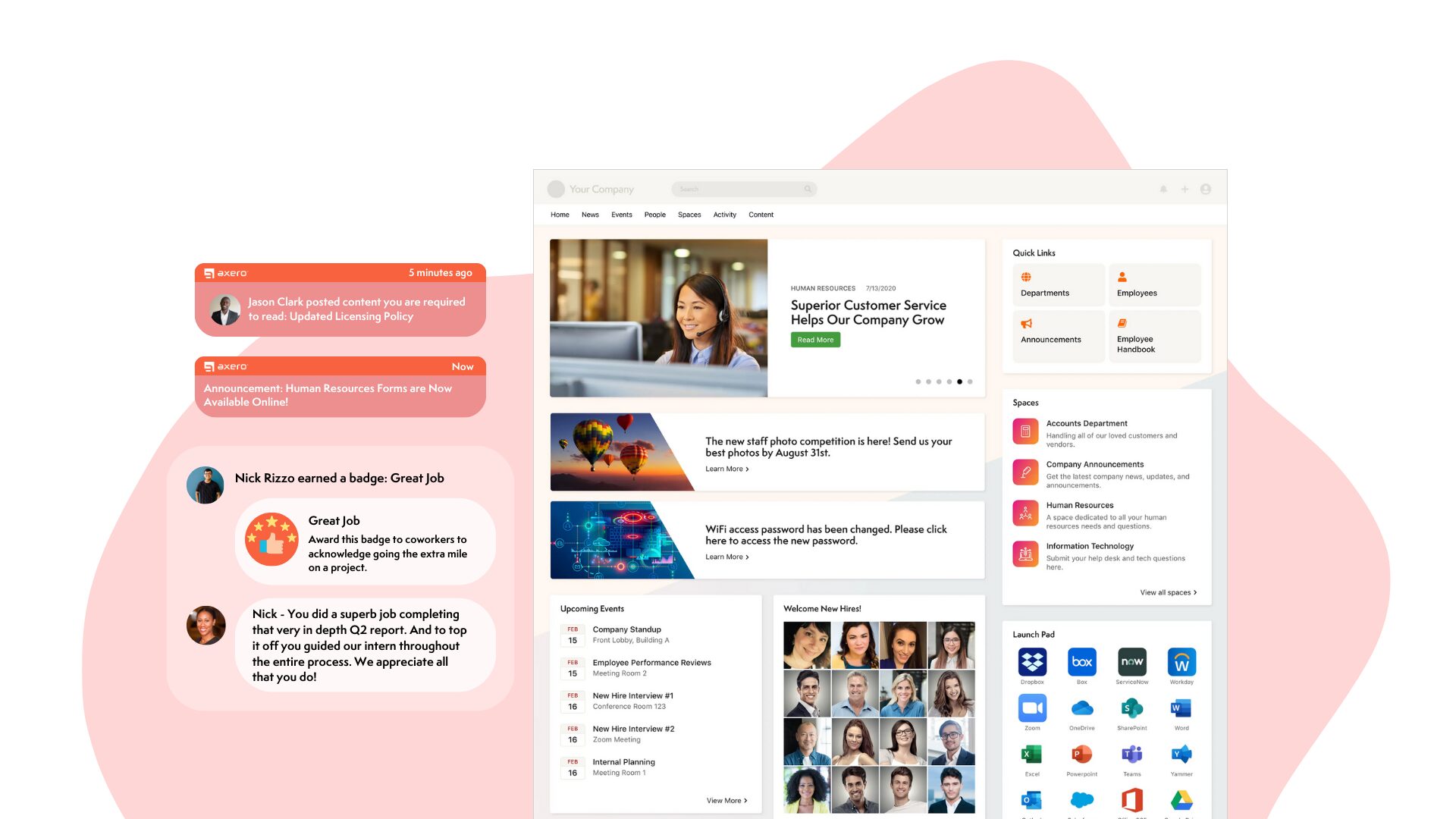What is the greatest asset to a business? Is it a color-coded spreadsheet that updates itself? Wrong! Is it an espresso machine that never breaks? Still wrong! Is it a patent for turning unpaid intern tears into clean energy? Wild—but still just shy.
The real top asset is your people.
We all know talented, skilled, and motivated employees are a company’s greatest asset. Employee happiness can be really powerful, even impacting a business’ success, workplace environment, and customer satisfaction.
In fact, research found happy workers are 13% more productive. This doesn’t sound like something that businesses want to sweep under the rug, well, unless a happy, productive workforce is too radical for the roadmap.
Let’s dive into what employee happiness really is, how happy employees benefit businesses, and how to measure and boost happiness at work.
What is employee happiness?
When you think about happy employees, what’s the first thing that comes to your mind? Maybe it’s a staged vignette of people in suits, laughing and patting each other on the back—for the enthusiastic types, there might even be a high five in there!
In reality, employee happiness goes beyond faux positivity and forced smiles. True employee happiness is manifested in workplaces that support flexibility, creativity, and a healthy work-life balance. This is summed up in Seligman’s PERMA model, a framework that recommends five key components for the actualization of well-being:
- Positive emotion: The experience of feel-good emotions such as joy, peace, hope, amusement, awe, and gratitude.
- Engagement: The ability to stay present with and gain enjoyment from work tasks.
- Relationships: Exposure to regular, positive interactions with colleagues.
- Meaning: A sense that work projects have a sense of purpose that makes them worthwhile doing.
- Accomplishment: The ability to achieve and celebrate goals, both independently and as a team.
Benefits of happy employees
Some employers may be tempted to brush employee happiness off as something not worth the energy. Who cares about making employees happy when there’s quotas to hit? However, when businesses get serious about improving employee engagement, it benefits not only employees but also the company as a whole.
Increased productivity (without the panic attacks).
As mentioned earlier, happy employees are more productive. This means that contributing to employee happiness is a key way to increase employee output in the workplace without resorting to high-stress motivation tactics. Just by nature, happiness radiates off of others and will encourage employees to work with more purpose.
Enhanced collaboration.
Collaboration and employee satisfaction feed into each other like a virtuous cycle. Employees with strong, collaborative workplace relationships are less lonely, and, as a result, feel happier. And when employees feel happier, they are more likely to exhibit a gracious attitude and strong team spirit.
Improved employee retention.
It goes without saying that if an employee enjoys being at work, they are less likely to want to move on to a new job. The thing is, high levels of employee retention aren’t only good for morale, they can also save your business money. A lot of money, actually, given that replacing an individual employee may cost between 1.5 to 2 times the employee’s annual salary.
Higher creativity.
What do a stressed-out employee and an artist have in common? Not much, it turns out. A recent 2024 research shows acute stress has a detrimental impact on creative capacity. On the other hand, multiple studies found a positive correlation between happiness and creativity.
When employees – or anyone, really – are in a good mood, they experience an increase in creative thinking. While resource limitations can lead to forced creativity in some cases, too much stress will usually make it more difficult to think straight, let alone come up with innovative ideas.
Lower absenteeism.
When your team actually wants to come to work, they are way less likely to call in sick with a “stomachache.” In 2023, stress and anxiety ranked #3 in the most common reasons for sick leave, just after stomach issues and COVID-19.
With 83% of U.S. employees now teetering on the edge of burnout, that number could be on the rise. Burnout is real, and it’s time for employers to take it seriously.
Healthier company culture.
Culture is made up of people, so when your people are happy, your company culture is too. A healthy company culture doesn’t just keep your current team around; it turns heads and brings top talents your way. In other words, happy employees = positive work environment = competitive edge in the job market!
How to measure employee happiness (and is it really possible?)
So now the question is: how do you measure happiness? And is it really possible to measure?
What we want to get out of the way first is the latter; the answer is yes. In fact, researchers attempted to measure happiness, from looking for biological markers for happiness (with only minimal success so far) and examining certain behaviors to other- and self-reports. The bottom line is, yes, happiness can be measured.
Now, the fun part, how to measure it! Self-report is “by far the most common way that researchers assess happiness,” according to Dr. Mark Holder, the Happiness Doctor himself. Self-reports, as the name suggests, can be carried out via surveys, questionnaires, and forms with multiple-choice, Likert-scale, sliding scale, and/or visual analog scale (VAS), to name a few.
In a work environment, this might look like an employee engagement survey, which can be utilized to get a feel for employee attitudes toward work and to find out areas a businesses can improve their human resources (HR) practices. Gallup’s Q12 engagement survey is a great template to build upon as they get right to the heart of happiness in the workplace:
- How satisfied are you with your company as a place to work?
- I know what is expected of me at work.
- I have the materials and equipment I need to do my work right.
- At work, I have the opportunity to do what I do best every day.
- In the last seven days, I have received recognition or praise for doing good work.
- My supervisor, or someone at work, seems to care about me as a person.
- There is someone at work who encourages my development.
- At work, my opinions seem to count.
- The mission or purpose of my company makes me feel my job is important.
- My associates or fellow employees are committed to doing quality work.
- I have a best friend at work.
- In the last six months, someone at work has talked to me about my progress.
- This last year, I have had opportunities at work to learn and grow.
You can tailor the questions to suit your people and what kind of insight you look to gather. The key is to keep it to the point. You want to understand what your employees think or feel, but you don’t want to waste their time in the process. By not wasting time, we mean that employees shouldn’t have to take extra steps to fill out the surveys; it should be seamless and easy to complete, ideally with the option to respond anonymously.
For admins or HR professionals, it should likewise be efficient to build, distribute, and collect data. The last thing you want is to source yet another external tool, add embed code (which, for some reason beyond cosmic comprehension, never works), share a link (wait, which link is final final?), download the data and upload it back to your internal system for analysis…
Doing an employee pulse check should not feel like tearing your heart out. Why go through all that unnecessary laborious process when you can do it all – built-in – on your very own Axero intranet?
With modern intranets like Axero, polls and surveys can be set up and circulated in minutes. Whether it’s company-wide, departmental, or project-based, you can go as coarse or granular as you want. Take full advantage of flexible questions (checkbox, radio button, textbox, etc.), real-time results, anonymous response options, and detailed stats and analytics. If that doesn’t make folks in HR happy employees, we frankly don’t know what will.
How to Boost Employee Happiness at Work
Let’s take the guesswork out of it. When you know where to look, keeping your employees happy is simpler than you think.
Commit to fair compensation and benefits.
Too many companies fall into the “pizza party” trap, where they assume that rewarding overworked employees with free pizza or any food of equivalent is going to keep morale high. Spoiler alert: it won’t. And in some cases it may have the opposite effect.
If employees are working their socks off, eyeing – rightfully so – a raise so they can comfortably pay their bills, a sad slice of pizza isn’t going to cut it. Companies should focus instead on ensuring that staff receive fair compensation and benefits for the work that they do.
When it comes to prioritizing employee happiness, sometimes the most obvious things are often the hardest to see or, worse, refused to be seen. Don’t be the latter.
Offer flexible working.
Now that knowledge workers have proven they can do their jobs — and excel — from anywhere with a reliable internet connection, there is little reason to stay tethered to a physical office. In fact, nearly half of remote American workers say they would quit if forced to return to the office full-time.
There are many types of flexible work arrangements you can offer:
- Remote work: Employees work from anywhere outside the office, often from home, but not exclusively.
- Hybrid work: A combination of in-office and remote work, typically structured by day or by role.
- Compressed workweeks: Employees work full-time hours over fewer days, such as a 4/10 schedule (four 10-hour days).
- Flextime with core hours: Employees choose their own start and end times, provided they are available during agreed core hours to support collaboration and meetings.
Remember, the key is “flexibility.” When employees feel like they don’t always have to schedule and plan their lives around work, they are more likely to feel trusted, empowered, and in control.
Build a truly supportive environment.
Actions speak louder than words, and that does ring true when it comes to whether employees feel supported. Trust begins to take root when, for example:
- Managers follow through on promises and advocate for their teams
- Team members share knowledge and have one another’s backs
- Seniors actively mentor and include new hires
When support actually shows up outside mission statements or posters in the breakroom, employees feel genuinely valued, more motivated, and far more likely to stay engaged and happy in their roles.
Recognize employees’ contributions.
Employee recognition comes in all shapes and sizes. It could look like an official year(s) of service certification, a public shoutout on the company intranet, a couple of extra PTOs, a gift card, and anything in between. Look, it doesn’t have to be grand gestures every single time; a simple “thank you” or “job well done” on the fly can go a long, long way.
When employees feel valued and that their contributions truly matter, a sense of belonging is built. In fact, recent research shows employees are 3.8% more likely to agree that they are strongly connected to the company culture when recognition is an important part of that culture.
Practice transparent communication.
More often than not, over-communicating causes fewer problems than under-communicating. Ambiguity leads to anxiety. When people don’t know what’s going on—or worse, suspect that information is being withheld—they become stressed, disengaged, and ultimately, unhappy.
Transparent communication goes beyond just how we talk to one another. In the workplace, it can mean sharing clear messages about company values, goals, metrics, and changes, building psychological safety and openness through an open-door policy, making meeting notes easily accessible, and giving regular, constructive feedback, to name a few.
Create growth opportunities.
We, as humans, are naturally wired to learn. As employees, we often thrive when we feel our work is meaningful and our efforts lead somewhere. When and if there are no professional development opportunities on the horizon, it’s only a matter of time before employees are tempted to take their talents elsewhere. Case in point: 63% of Americans who left a job in 2021 – during The Great Resignation – did so because of the lack of opportunities for advancement, with 33% citing it as a major reason.
According to LinkedIn’s 2025 Workplace Learning Report, the top 3 career development practices are leadership training, sharing internal job openings, and, tied for third place, career development plans and mentorship programs. Growth opportunities like these signal that companies value their employees’ contributions and see their potential.
Encourage creativity and autonomy.
Creativity allows individuals to contribute in a way that reflects their strengths and personality, which makes work feel more aligned with their identity—feel more “personal” to a certain extent. When they are empowered to take ownership, it’s only natural for them to follow through with their initiatives and outcomes.
Autonomy at work takes away silos. It promotes confidence and willingness to contribute, ask questions, and challenge the status quo in a healthy way. When employees feel trusted, inspired, and allowed to think freely, they are happier, more loyal, and perform at a higher level. It’s a win-win for everyone.
Equip employees with the right tools.
Last but not least, you cannot expect A+ results if they are slowed down by tools that belong in the last decade. This includes literally everything, from a laptop (unless it’s BYOD) and a proper desk setup to software and tools used on a daily basis.
As you might have been able to guess by now, employee happiness hinges A LOT on whether they feel connected and are a part of a wider community regardless of where and how they work. What glues happy employees together is naturally a space where they can collaborate effectively, share and celebrate wins, and ultimately make a positive impact. And this is where Axero comes in.
More than just a company intranet, Axero serves as a centralized hub for your teams, allowing employees to connect, engage, and share knowledge and resources, whether they are sitting at HQ or working the frontline on the other side of the world.
Let’s make unhappy employees a thing of the past. Good vibes 🤝 great work, see Axero in action today.

















 info@axerosolutions.com
info@axerosolutions.com 1-855-AXERO-55
1-855-AXERO-55


